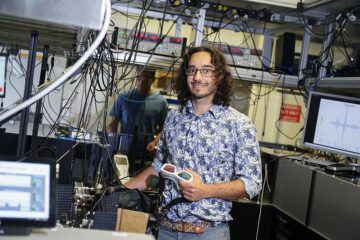Assay for the Diagnosis of Alzheimer’s Disease

</a><strong>Background</strong><br>
Current methods to diagnose Alzheimer´s Disease (AD) comprise computer tomography (CT), magnet resonance imaging (MRI) or positron emission tomography (PET) visualizing abnormalities in the brain. Other approaches concerns to the determination of biomarkers such as tau/ phospho-tau or beta Amyloid in body fluids (blood, liquor). However, CSF level of tau is a general marker for neuronal dysfunction and not specific for AD alone (also increased in Creutzfeldt Jacob). In AD patients, decreased levels of Abeta42 could be shown, however the values of concentrations in various AD patients differ dramatically so that Abeta42 alone is not a sufficient reliable marker. Furthermore Abeta42 seems to be decreased only in patients who already have clinical symptoms of AD. It is a strong medical need for diagnostic markers which are able to predict AD at a very early stage before clinical symptoms occur. This would allow earlier treatments before neuronal damage starts. <br><br> <strong>Technology</strong><br> We offer a novel approach for the early recognition of pre-symptomatic stages of AD even 20-30 years before clinical changes/ symptoms like mild cognitive impairment (MCI) or AD occur. The assay is based on the detection of the Aß38:Aß42 concentration ratio. A decrease of the Aß38:Aß42 ratio (value <1,5) in a phenotypically healthy, pre-symptomatic person is hypothized to be indicative that this person will develop MCI and AD later in life. This statement is based on findings in the human neuroblastoma cell line SHSY5Y stably expressing APP by investigating the expression and procession of AAP and is further based on postulating a gamma-secretase cleavage mechanism of APP-TMS (TM: transmembrane).<br><br> <b>Benefits:</b><ul> <li>Prediction of AD at a very early stage before clinical symptoms are visible</li> <li>Early prediction allows early prevention before neuronal damage occurs</li> <li>Method could help to monitor success of an early treatment</li></ul> <p><strong>IP Rights</strong><br> European Patent application was filed in June 2006<br> Patent pending in US, IN, CN<br> Patent granted in DE, FR, GB, IT, ES <br><br> <strong>Patent Owner</strong><br> Freie Universität Berlin
Weitere Informationen: PDF
ipal GmbH
Tel.: +49 (0)30/2125-4820
Ansprechpartner
Dr. Dirk Dantz
Media Contact
Alle Nachrichten aus der Kategorie: Technologieangebote
Neueste Beiträge

Neue universelle lichtbasierte Technik zur Kontrolle der Talpolarisation
Ein internationales Forscherteam berichtet in Nature über eine neue Methode, mit der zum ersten Mal die Talpolarisation in zentrosymmetrischen Bulk-Materialien auf eine nicht materialspezifische Weise erreicht wird. Diese „universelle Technik“…

Tumorzellen hebeln das Immunsystem früh aus
Neu entdeckter Mechanismus könnte Krebs-Immuntherapien deutlich verbessern. Tumore verhindern aktiv, dass sich Immunantworten durch sogenannte zytotoxische T-Zellen bilden, die den Krebs bekämpfen könnten. Wie das genau geschieht, beschreiben jetzt erstmals…

Immunzellen in den Startlöchern: „Allzeit bereit“ ist harte Arbeit
Wenn Krankheitserreger in den Körper eindringen, muss das Immunsystem sofort reagieren und eine Infektion verhindern oder eindämmen. Doch wie halten sich unsere Abwehrzellen bereit, wenn kein Angreifer in Sicht ist?…

















